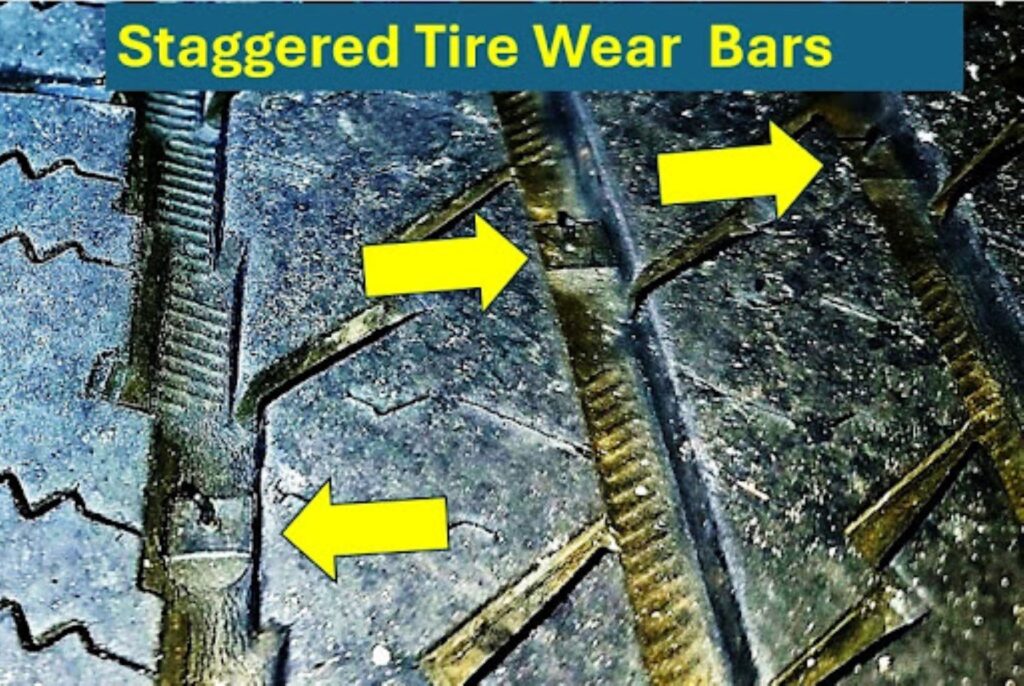Every wheel has tire wear bars as mandated by the law. These bars are often found within the groove of a tire, embedded between the bottom of the grooves and the treads. Paying attention to how these bars look in your tires is a must for safe driving, so keep an eye on them.
What Are Wear Bars on Tires?

Tire wear bars indicate when it’s time for a tire to be replaced.
When the tread wears down to the point that it’s even with the wear bars, it’s tire replacement time. It means the tire is too worn out to get a good grip on the road.
What is Tread Depth?
Tread depth refers to the distance between the top of the tire’s tread and the bottom of the tire’s grooves. Most tire treads have an average depth of 10/32 inches.
The depth of a tire typically decreases the more a tire is used, often requiring total replacement at 2/32 inches and below.
Where Are the Wear Bars Located?
Tire wear bars are often located on the lowest usable point of your tire’s treads. There are different types of tire wear bars, but most can be seen throughout the perimeter of the tire. They’re distributed evenly and spaced out across each of the grooves.
What Happens if Tires Lose Their Tread?
Tire treads provide the traction vehicles need to maintain control at any speed. They produce the grip necessary to move the vehicle forward when accelerating.
Traction also helps drivers retain control of their vehicle when driving on slippery terrain, such as roads slicked with mud, ice, or water.
If a tire were to lose its treads, two things would happen. The first is that the tire would lose grip and traction, making the vehicle more likely to skid out of control when driving. The second is that the tire becomes more vulnerable to puncture damage.
How to Reduce Tire Wear
Unfortunately, tires don’t last forever. While you’ll need to replace them sooner or later, there are ways to minimize tire wear and prolong your tire’s lifespan.
Rotate Your Tires
Driving without rotating your tires means the tread will consistently wear down in the same spots.
By rotating your tires once every six months, the wear areas will be distributed more evenly. That means you can get more mileage out of them before needing to get them replaced.
Replace All Four Tires at the Same Time if You Can
It’s a good practice to replace all four tires at the same time to make sure they wear down evenly. Doing this also minimizes how many trips you need to take to the mechanic to have your tires replaced.
Make sure all four tires you install are the same to guarantee consistent performance, durability, and handling.
Keep the Tires Properly Inflated
If your tires are at that perfect sweet spot between over-inflated and under-inflated, they’ll be significantly better at distributing the force exerted by your vehicle to the road.
Proper tire inflation doesn’t completely prevent wear and tear, but it does make your tires last significantly longer — all while improving your driving experience by making the ride smoother. Properly inflated tires also last longer and improve your vehicle’s fuel efficiency.

Alternate Ways to Check the Treads on Your Tires
It pays to know different ways to check your tire treads. Here are two alternate methods to check the treads that don’t depend on tire wear bars.
Tread Depth Gauge
The most precise and effective way to check the treads on your tires is to use a tire depth gauge. This tool uses a measuring pin that can fit inside the grooves of a tire to measure the tread’s depth.
Here are some of the steps involved when using a tread depth gauge:
- Press the tread depth gauge against a flat surface and adjust the measuring pin until it gives you a reading of 0/32.
- Insert the measuring pin into the tread groove and push the gauge down until the base lies flat against the treads of the tire.
- Lift the gauge and check the reading.
- Repeat the process two more times and average out all the readings to get an accurate measurement of your tire’s depth.
If your tire gives you a reading of 2/32 inches or lower, it’s time to replace it because it lacks the depth necessary to give your tires adequate grip.
Penny Test? That’s Outdated. Here’s the Update
For years, conventional wisdom was to test tread depth using the penny method by taking a penny and placing it into a groove tread upside down (Lincoln’s head first).
More conventional studies have shown the penny method isn’t adequate and you should use a quarter and the top of Washington’s head. Using the quarter method, if you can see the top of George’s head, the tire is below the minimum tread depth.
More conventional studies have shown the penny method isn’t adequate and you should use a quarter and the top of Washington’s head. Using the quarter method, if you can see the top of George’s head, the tire is below the minimum tread depth.
–Richard McCuistian, ASE Certified Master Automobile Technician
Where to Get New Tires for Your Vehicle
Tires are generally wear items you’ll need to replace after some time. And if you’re a preventive car owner, you’ll want to replace them as soon as possible to prevent blowouts.
Here at CarParts.com, the best aftermarket wheel and tire packages are at your fingertips. Our wheels and tires underwent stringent testing procedures, so you can rest assured that they’re built to deliver the best performance possible.
Find the right wheel and tire package for your daily driver by entering its year, make, and model into our vehicle selector. For a more personalized shopping experience, you can also use the search filters to find a package according to your preferred brand, price range, and more.
Never go over budget when you shop from us. All our products come with a low-price and lifetime replacement guarantee, so you don’t have to break the bank for your repairs.
Thanks to our strategically located warehouses across the US, we can get your order delivered straight to your doorstep in as fast as two business days.
Don’t miss out on the best deals on the market, and shop for a high-quality wheel and tire package today!
Any information provided on this Website is for informational purposes only and is not intended to replace consultation with a professional mechanic. The accuracy and timeliness of the information may change from the time of publication.































